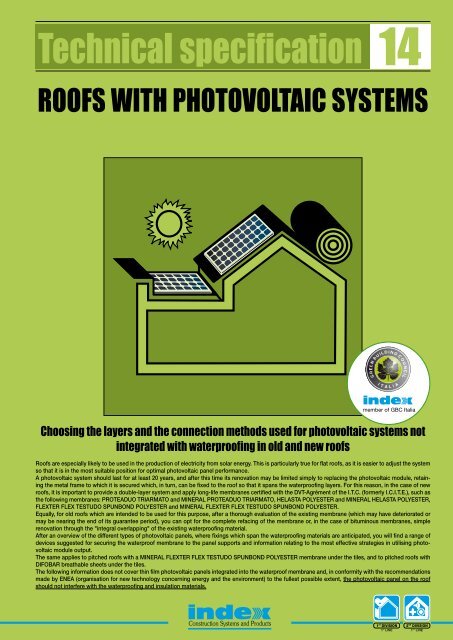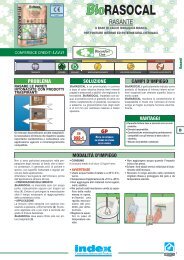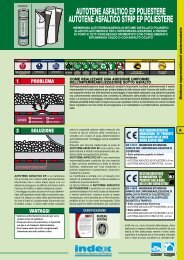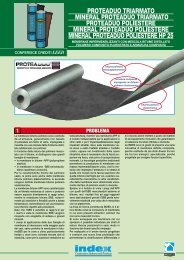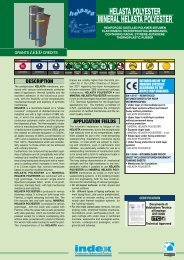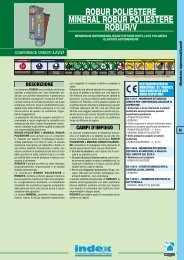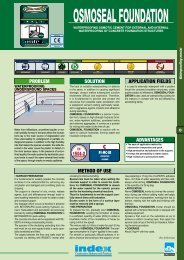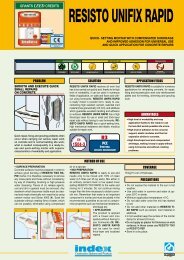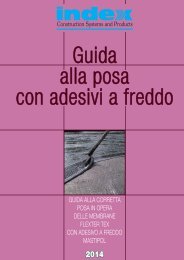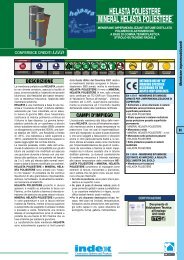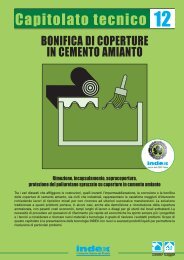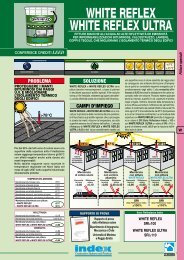ROOFS WITH PHOTOVOLTAIC SYSTEMS - Index S.p.A.
ROOFS WITH PHOTOVOLTAIC SYSTEMS - Index S.p.A.
ROOFS WITH PHOTOVOLTAIC SYSTEMS - Index S.p.A.
You also want an ePaper? Increase the reach of your titles
YUMPU automatically turns print PDFs into web optimized ePapers that Google loves.
Technical specification14<strong>ROOFS</strong> <strong>WITH</strong> <strong>PHOTOVOLTAIC</strong> <strong>SYSTEMS</strong>member of GBC ItaliaChoosing the layers and the connection methods used for photovoltaic systems notintegrated with waterproofing in old and new roofsRoofs are especially likely to be used in the production of electricity from solar energy. This is particularly true for flat roofs, as it is easier to adjust the systemso that it is in the most suitable position for optimal photovoltaic panel performance.A photovoltaic system should last for at least 20 years, and after this time its renovation may be limited simply to replacing the photovoltaic module, retainingthe metal frame to which it is secured which, in turn, can be fixed to the roof so that it spans the waterproofing layers. For this reason, in the case of newroofs, it is important to provide a double-layer system and apply long-life membranes certified with the DVT-Agrément of the I.T.C. (formerly I.C.I.T.E.), such asthe following membranes: PROTEADUO TRIARMATO and MINERAL PROTEADUO TRIARMATO, HELASTA POLYESTER and MINERAL HELASTA POLYESTER,FLEXTER FLEX TESTUDO SPUNBOND POLYESTER and MINERAL FLEXTER FLEX TESTUDO SPUNBOND POLYESTER.Equally, for old roofs which are intended to be used for this purpose, after a thorough evaluation of the existing membrane (which may have deteriorated ormay be nearing the end of its guarantee period), you can opt for the complete refacing of the membrane or, in the case of bituminous membranes, simplerenovation through the "integral overlapping" of the existing waterproofing material.After an overview of the different types of photovoltaic panels, where fixings which span the waterproofing materials are anticipated, you will find a range ofdevices suggested for securing the waterproof membrane to the panel supports and information relating to the most effective strategies in utilising photovoltaicmodule output.The same applies to pitched roofs with a MINERAL FLEXTER FLEX TESTUDO SPUNBOND POLYESTER membrane under the tiles, and to pitched roofs withDIFOBAR breathable sheets under the tiles.The following information does not cover thin film photovoltaic panels integrated into the waterproof membrane and, in conformity with the recommendationsmade by ENEA (organisation for new technology concerning energy and the environment) to the fullest possible extent, the photovoltaic panel on the roofshould not interfere with the waterproofing and insulation materials.Technical specifications1 st DIVISION1 st LINE<strong>ROOFS</strong> <strong>WITH</strong> <strong>PHOTOVOLTAIC</strong> <strong>SYSTEMS</strong>2 nd DIVISION1 nd LINE1
INTRODUCTIONThe architecture used in sustainable buildingis not limited to the design of a “conserving”shell in terms of energy: current design researchis intended to make the building shellperform an “active” energy role through theapplication of solar energy collectors and photovoltaicsystems for solar energy production.The European Directive promoting the use ofrenewable energy sources (Directive 2001/77/EC), assimilated in Italy through Law Decree387 of 2003 and followed up by subsequentimplementation regulations, introduced ContoEnergia, a working account scheme incentivisingthe production of electricity using solarenergy from photovoltaic systems connectedto the electricity mains on a permanent basis.Italy is one of the sunniest European countries,especially in the Southern regions, butits photovoltaic industry is one of the leastdeveloped in the world.It is estimated that in Italy, using current technology,a photovoltaic system is capable ofgenerating approximately 1150 kWh per yearfor each kWp of photovoltaic modules installed,a value which gradually rises to 1500kWh as you move southwards. Germany, inspite of its less favourable geographical position,is particularly advanced in its productionof electricity from solar energy; however, foreach kWp of photovoltaic modules installed,just 600 kWh/kWp is produced per year.Italy's favourable climatic situation allows thebeneficiary to recoup all outlay costs withinthe space of ten years, and to make approximatelythe same amount in the following tenyears. In the south, the situation improveseven further, as the investment tends to berepaid within approximately 8 years. Roofs ontop of buildings, especially non-walkable flatroofs with a visible waterproof covering, areGBC ITALIA (Green Building Council)AND LEED CERTIFICATIONGBC Italia, to which INDEXbelongs, has the task of usingthe guidelines commonto everyone in the LEEDinternational community todevelop the characteristicsof the LEED Italia sys-member of GBC Italiatem, which must take intoconsideration the specific climatic, buildingand legislative conditions in Italy.LEED opts for a view of sustainability by makingthe most of all opportunities to reduce thevarious kinds of environmental impacts andharmful emissions of the buildings being built.The LEED (Leadership in Energy andEnvironmental Design) standards are parametersfor sustainable building developed in theUSA and applied in 40 countries throughoutthe world. They indicate the requirementsfor eco-compatible buildings, able to “work”sustainably and self-sufficiently energy-wise. Itis essentially a rating system for the developmentof “green” buildings.LEED is a certification, which may be obtainedon a voluntary basis, where the designer actuallydeals with collecting data for the assessment.The system is based on the awardof credits for each of the requirements thatcharacterise the sustainability of the building.The certification level achieved comes fromthe sum of the credits.unused surfaces which could conveniently beutilised for the production of electricity fromsolar energy by means of a photovoltaic solarThe assessment criteria used by LEED (2009version) are grouped into six categories (+1only valid in the USA), which envisage one ormore compulsory prerequisites and a numberof environmental performances that conributeto the building’s final score:• Sustainable sites(1 prerequisite, 26 points)• Efficient water consumption(1 prerequisite, 10 points)• Energy and atmosphere(3 prerequisites, 35 points)• Materials and resources(1 prerequisite, 14 points)• Indoor environmental quality(2 prerequisites, 15 points)• Innovation and design process (6 points)• Regional priority (4 points) only applicablein the USAThere are 4 rating levels:• Certified: between 40 and 49 points• Silver: between 50 and 59 points• Gold: between 60 and 79 points• Platinum: more than 80 pointsThe following point in the LEED regulationsincludes the solar reflectance index:• SS Credit 7.2: Heat Island Effect - RoofSRI (solar reflectance index) limits of the roofingmaterialspanel system, in compliance with sustainablebuilding criteria.USEFUL INFORMATIONREGARDING <strong>PHOTOVOLTAIC</strong>PANELS INSTALLED ON A ROOFOrientation and slopeThe ideal orientation and slope for photovoltaicpanels is facing south, at approx. 30°; however,satisfactory results can also be achieved withsouth-east and south-west facing panels, atsloping angles of 20° and 40°.On a flat surface, output is reduced by approximately10% in relation to the figure achievedusing the ideal slope.System withdirected modulesSystem with flat,rigid modulesOutput and surfacesPhotovoltaic panels currently on the marketuse various technologies, offering differentperformance levels. Using high-output modulesto achieve a given power value only requires asmall surface area, saving space and makingit easier to position the panels in the sunniestareas on the roof, avoiding shady spots.The mass per unit area of a photovoltaicsystemThe weight per square metre of the photovoltaicsystem is particularly important; it must bealigned with the extra load capacity of the roof.The load not only depends on the unit weightof the panel, but also on the roof installationmethod used.The impact of panels secured by means of aballast (in order to avoid puncturing the waterproofcovering) is linked to the amount of windin the area and the geometry of the roof, and isgreater than the impact of systems which aremechanically fixed to the support (the averageweight is 40-50 kg/m 2 ).However, innovative tubular photovoltaic modulesare available which do not require ballastsor fixings; these can withstand winds of around208 km/h and weigh 16 kg/m 2 .Ballasted systemSystem fixedmechanicallySystem with supportedinterlocking modules2 <strong>ROOFS</strong> <strong>WITH</strong> <strong>PHOTOVOLTAIC</strong> <strong>SYSTEMS</strong> Technical specifications
Supported tubularsystemThe wind and air do notcatch the tubesTemperatureThe declared performance of the photovoltaicpanels is for a temperature of 25°C, but youshould bear in mind that in crystalline siliconpanels this drops as the temperature increases(by 0.3 - 0.4% for every °C); a black surface onthe roof can reach temperatures of over 70°C.Ventilation at the rear of the panel and a reducedsurface temperature for the roof onwhich the system is installed are therefore ofgreat importance for optimum performance.Cleaning the panelPanel efficiency is closely linked to the regularcleaning of its surface. Only glass-coated panelsoffer efficient cleaning but the deposits leftby standing water must be removed, otherwisethe panel will not produce any energy.This is of such importance that panels are nowbeing made without aluminium frames, to preventeven the smallest amount of water fromcollecting on the panel.Solar radiationOverall solar radiation reaching the photovoltaicmodule can be split into three components: directradiation, diffused radiation and reflectedradiation.Direct radiation is the segment of radiationdirectly reaching the photovoltaic module, forexample on days when the sky is clear.Diffused radiation is a segment of direct radiationwhich is diffused as it passes throughclouds and particles in the atmosphere. This iswhy the panel still produces energy - albeit on alesser scale - when the sky is overcast.Finally, reflected radiation is the segment ofsolar radiation reflected towards the panel bythe surrounding environment, for example whenthere is snow on the roof. Reflected radiationtherefore depends on the materials surroundingthe photovoltaic field and, with suitabledevices, can increase performance in traditionalpanels. It can become especially important forpanels which use more than the surface facingthe sun to produce energy, such as the tubularmodels.Tubular models andsloping panels areventilated at the rearDiffused radiationDirectradiationVentilationReflectedradiationVentilationINFLUENCE OF THE WATERPROOFCOVERING ON THE <strong>PHOTOVOLTAIC</strong>SYSTEM INSTALLED ON THEROOFIn the previous chapter we saw how temperatureand reflected radiation can influence photovoltaicsystem output. Both are determinedby the surface colour of the waterproof coveringon which the panel is mounted.Over 90% of roofs are dark coloured and thesurface directly under the solar radiation reachestemperatures of around 80°C, with a negativeimpact on photovoltaic panel output, whichlessens as the temperature increases.Increasing roof surface reflectance by meansof special treatments applied to the surface ofthe waterproof covering offers the dual benefitof reducing the temperature to a value as lowas 40°C while raising the albedo, the fraction ofincident radiation reflected by the roof surface,to increase photovoltaic system output.INDEX systems used to increase roofreflectanceThe choice of colour for the uppermost layer ofthe waterproof covering (which ideally shouldhave mineral self-protection (MINERAL) providedby slate granules as this is the most durableoption and is not subject to the problemssuffered by membranes with metallic self-protection)is the first strategy applied to increasesolar radiation reflectance. The table below liststhe temperatures reached in summer by variouswaterproof covering finishes; this clearly illustrateshow a white slate membrane reduces thetemperature of the roof.Due to their shiny surface, self-protected metalfoil membranes offer high solar reflectance butlow infrared emissivity; once oxidised, IR emissivityincreases but solar reflectance is reduced.Aluminium paints only offer modest longevity.Temperature levels reached by the waterproofcovering with different surface finishesexposed in the same conditions to summersolar radiationSurface finishBlack bituminous membraneGrey slate membraneWhite slate membranePainted aluminium bituminousmembraneSelf-protected membrane withcopper foilSelf-protected membrane withaluminium foilMax. Temp.78°C74°C70°C67°C60°C55°CTechnical specifications<strong>ROOFS</strong> <strong>WITH</strong> <strong>PHOTOVOLTAIC</strong> <strong>SYSTEMS</strong>3
the new index solutionsSlate membranes painted withMINERAL REFLEX WHITEThe MINERAL REFLEX WHITE treatment formembranes in the MINERAL range is based onthe application of a special high saturation andluminosity white mineral self-protection whichallows the creation of roofs with high solarreflectance levels and extremely high thermalemissivity levels.A dark roof will have very low solar reflectancelevels, and during the day will absorb alot of heat which is not effectively dispersedovernight, even if it has high infrared emissivity.A roof with aluminium paint offers good solarreflectance, which reduces heat absorptionduring the day but slows down overnight heatdispersal due to its low IR emissivity.A MINERAL REFLEX WHITE roof offers gooddaytime reflectance as well as high overnightemission, meaning heat absorption is lowerand resulting in beneficial effects in terms of theenergy consumed in summertime by air conditioninginside the building.The MINERAL REFLEX WHITE treatment pro-MINERAL REFLEX WHITE FLEXTER TESTUDOReflectanceR=45%EmissivityE=94%Solar Reflectance <strong>Index</strong> SRI*= 52 - 54%* SRI depending on wind speed:low=52%, medium=53% and high=54%.LEGENDReflectionEmissivityHeat accumulated andtransmitted to the structureEmissivity: 0.94ReflectanceReflectance0.450.4-0.45Reflectance29 requirementcorresponding to LEEDCredits:• SS Credit 7.1. Heat island effect:Underground car park roofs• SS Credit 7.2. Heat island effect: Roofsmember of GBC ItaliaRural environment Suburban areas Commercial areas Cities Residential areas Parks CountrysideWHITE REFLEX paintThe INDEX Research and Development departmenthas developed WHITE REFLEX, anew water-based paint which, when appliedto waterproof membranes on roofs with visiblecoverings, reduces their daytime temperatureand allows rapid cooling at night; this lessensheat transmission into living spaces andReflectanceReflectance>0.80 Reflectance0.4-0.450.90Emissivity: 0.80LEGENDReflectionEmissivityHeat accumulated andtransmitted to the structureTemperature levels reached by the waterproofcovering with different surface finishesexposed in the same conditions to summersolar radiationSurface finishBlack bituminous membraneGrey slate membraneWhite slate membranePainted aluminium bituminousmembraneMINERAL REFLEX WHITEmembraneSelf-protected membrane withcopper foilSelf-protected membrane withaluminium foilBituminous membrane withWHITE REFLEX paintMax. Temp.78°C74°C70°C67°C65°C55°C42°Coutweighs that of metal self-protected membranesand, as you can see from the tableabove, is even more effective than theMINERAL REFLEX WHITE treatment.4 <strong>ROOFS</strong> <strong>WITH</strong> <strong>PHOTOVOLTAIC</strong> <strong>SYSTEMS</strong> Technical specifications
REFLECTANCEBlack bituminous membrane 0.80EMISSIVITYBlack bituminous membrane >0.80Painted aluminium membrane 0.90The application of a WHITE REFLEX paint,which can maintain the temperature of thewaterproof covering at a value around 40°C,reduces the temperature of the rigid crystallinesilicon photovoltaic panel by 10 - 20°C, increasingits output by 3 - 8%. Photovoltaic paneloutput rises as the environmental luminosityincreases.The WHITE REFLEX reflective paint increasesalbedo, improving photovoltaic panel output.It is estimated that the combination of thesetwo effects increases the output of photovoltaicpanels with traditional concentration (consistingof crystalline or polycrystalline cells) by around4 - 10%.To demonstrate and prove this statement,WHITE REFLEXSolar Reflectance <strong>Index</strong>SRI>100In compliance with GreenBuilding Council criteria, theWHITE REFLEX paint used onthe slate membrane helps tosatisfy the following LEED criteria:member of GBC ItaliaLEED - EA Credit 1: OptimiseEnergy PerformanceCool roofs with WHITE REFLEX paint can bemodelled in the design proposal to demonstratethe impact in the reduction of free heat contributions.If the suggested roof has an initial reflectanceof at least 0.70 and an emissivity of atleast 0.75, the design proposal may use a modelledreflectance of 0.45, thus taking account ofits degradation, as opposed to the default valueof 0.30 modelled on the reference building.ROOF <strong>WITH</strong> WHITE REFLEXReflectance >0.80Emissivity >0.90LEED - SS Credit 7.2. Heat Island Effect - RoofsRoofs painted with WHITE REFLEX reduce the“heat island” effect (differences in heat gradientbetween urban areas and green spaces) andminimise impact on the surrounding microclimate,as well as human and animal habitats.Option 1: requires roofing materials with a SolarReflectance <strong>Index</strong> (SRI) equal to or greater thanthe values indicated in the table below for aminimum of 75% of the roof surface.Gently sloping pitchedroofs≤2:12(9.5°-16.7%)Steep pitchedroofs>2:12(9.5°-16.7%)Roof withWHITE REFLEXLEED standardSRI≥78LEED standardSRI≥78SRI≥100Option 3: Install high albedo and vegetated roofsurfaces that together meet the following criteria:(Area of roof meeting minimum SRI/0.75)+ (Area of vegetated roof/0.5) ≥ Total roof areaLEED - EA Credit 2: On-Site Renewable EnergyWHITE REFLEX increases the output of photovoltaicsolar panels, one of the systems usedin the on-site production of energy from renewablesources, permitted in point EA 2 andused to balance the energy consumption of thebuilding (the estimated rise is 4 - 10%, testsare currently being conducted on roof-installedsystems).INDEX has been conducting a series of on-sitetests and laboratory trials since 2007, in collaborationwith the University of Modena andReggio Emilia.In addition to waterproofing tests on the mostvaried application surfaces, specific examinationshave been conducted to assess potentialincreases in energy production which can be attributedto the presence of a reflective supporttreated with WHITE REFLEX.Since April (the month in which WHITE REFLEXwas applied), the energy production levels of aphotovoltaic system with crystalline silicon cellshave been monitored.This is located on a roof measuring approx. 700m 2 so that a comparison can be made betweenbefore and after the reflective cooling treatmentis applied using WHITE REFLEX paint.Technical specifications<strong>ROOFS</strong> <strong>WITH</strong> <strong>PHOTOVOLTAIC</strong> <strong>SYSTEMS</strong>5
The above output comparison relates to a5-month period (May to September) in 2009(untreated roof with a visible black bituminouscovering) and in 2010 (after treatment).To obtain a rough - but nonetheless indicative- evaluation, the data was comparedwhile taking account of sunshine hours byconsulting meteorological tables for themunicipality of San Giovanni in Marignano(RN).From the calculations performed, discountingthe days affected by persistent rain andassuming production was halved on dayswhen the weather was stormy, it was immediatelyevident that despite a markedincrease in rainfall (mostly occurring in May2010), the system maintained a constantenergy production level over the 5-monthperiod. The final column, listing the datamost relevant to the original purpose of thetest, energy production (in the form of suggestedenergy per sunny day), contains significantlyincreased values and correspondsto a figure of around 8%.In conclusion, a commercial assessmentmay now also be conducted in order toquantify the financial benefit of using extremelyhigh solar reflectance WHITEREFLEX paint.Once the necessary conditions for the approximationof sampling data have beenmet (the periods and sunlight intensity arenot yet firmly established) and the deteriorationand loss of output for the system havebeen calculated (the manufacturers indicatethat any decline in output takes place veryearly on within the operating period), andtaking account of the potentially saleableenergy produced as well as the amountnot required by the mains supply user, thesystem would have yielded an excess ofapproximately 8400 Watts, which is almostenough to cover the cost of purchasingand applying the paint.In short, we could say that the work paysfor itself over the course of a year and creates"wealth" in following years.POWER FIELDIn addition to the systems equipped with crystallinesilicon (used in approximately 85% ofapplications up to this point), other types ofphotovoltaic panels are now becoming morewidespread in Italy.One of the most interesting is an Americanproducedtype, a revolutionary product dueto its easy installation and maintenance procedures,which does not require the use ofmechanical fixing elements or ballasts on theroof. These systems have cylindrical elementsin CIGS (copper, indium, gallium, diselenide),capable of capturing both direct and reflectedsolar radiation from the roof treated with WHITEREFLEX.The increases in energy production should beeven more consistent than the results recordedin the previous test.In the summer of 2009 (application took placeon 29th June) a test was performed which providedsome particularly interesting results.On the date of the first on-site inspection, thecylindrical cell system located on a small roof(approx. 100 m 2 ) with a bituminous surfacecovering self-protected with green slate granuleswas producing energy at a deficit of 36%in comparison with the nominally anticipatedfigure.The system dysfunction was due to the badsolar reflectance values of the roof; the subsequentapplication of WHITE REFLEX paintwould have demonstrated this hypothesis.6 <strong>ROOFS</strong> <strong>WITH</strong> <strong>PHOTOVOLTAIC</strong> <strong>SYSTEMS</strong> Technical specifications
1 month after application, the energy productiondata was retrieved and, as illustrated by thegraph (see previous page), an increase of 30%was recorded in the current field (and thereforethe power field) produced.The other graph (adjacent to this paragraph)corresponds to the energy produced by thesystem over the course of one sunny day, beforeand after treatment with WHITE REFLEX;it shows a significant improvement, especiallyin the hours in which albedo is at its worst (earlymorning and sunset).DIFFERENCE BETWEEN ANTICIPATED POWER AND ACTUAL POWERTimeBEFOREAfter application the effect of the paint couldbe detected immediately, albeit in a generalisedmanner, by using a solarimeter to measure solarradiation. Solar reflectance increased roughlysevenfold.AFTERIn conclusion, although the experiment is notyet complete, a roof with high solar reflectanceis entirely necessary for cylindrical cellsystems and WHITE REFLEX paint, thanks toits considerable application flexibility (it canbe used on almost all supports), should beMembrane - DifferenceMembrane+<strong>Index</strong> - Differenceconsidered as one of the most viable solutions.SOME RECOMMENDATIONSextracted from the “L’ENERGIA FOTOVOLTAICA” (<strong>PHOTOVOLTAIC</strong> ENERGY) publication by ENEACreating a photovoltaic system is not too complicated, but it is a jobwhich should be carried out by specialists. It is nevertheless useful tofamiliarise yourself with a few rules which should be observed in thedesign and application phases.The support structures should be constructed to last at least as longas the system itself, i.e. 25-30 years, and should be installed so as toallow easy access to modules for cleaning and replacement, and toelectric junction boxes for inspection and maintenance. They must alsobe entirely resistant to corrosion and wind.Photovoltaic generators installed on roofs must not interfere with thewaterproofing and insulation of the surfaces; in some cases it may benecessary to create fixed or mobile walkways.A gap must be left between modules, from a minimum of 5 mm for generatorsinstalled in parallel and near other fixed surfaces, up to 5 cm forgenerators which may be subjected to high wind pressures.In the case of roof- or wall-mounted modules, it is essential that a gapof 4-6 cm is left between them so as to guarantee sufficient air circulationand therefore effective cooling of the surface on which the moduleis installed.The interconnecting electricity cables and junction boxes must besuitably sized, conform to electrical regulations and guarantee thespecified insulation, protection and waterproofing classes as required.EDITO DA: ENEA - LUNGOTEVERE THAON DI REVEL, 76 - 00196 ROMA - LUGLIO 2006 - DESIGN: EDIZIONI ALTEA S.R.L. - STAMPA: PRIMAPRINT (VITERBO)S V I L U P P OS O S T E N I B I L EG22-065-022SVILUPPO S OSTENIBILEL’ENERGIA FOTOVOLTAICATechnical specifications<strong>ROOFS</strong> <strong>WITH</strong> <strong>PHOTOVOLTAIC</strong> <strong>SYSTEMS</strong>7
WATERPROOFING AND THERMAL INSULATIONNEW FLAT <strong>ROOFS</strong> OR COMPLETE REFACING PROJECTS6. Waterproofing membrane(second layer)5. Waterproofing membrane(first layer)1. Support2. Primer3. Vapour barrier4. ThermalinsulationSTRATIFIED ELEMENTS1. Support2. Primer3. Vapour barrier4. Thermal insulation5. Waterproofing membrane (first layer)6. Waterproofing membrane (second layer)PRIMERThe primer penetrates into the pores of concretesurfaces, stops dust and has the job ofpromoting adhesion on the surfaces to whichthe membranes must be stuck. INDEVER is atraditional solvent-based bituminous primer; theECOVER water-based primer is more innovativeand offers a reduced environmental impact. Thewhole surface to be covered and the verticalparts onto which the waterproof layer must bestuck are painted with a coat of about 300 g/m 2INDEVER adhesion bituminous primer, a solutionbased on oxidised bitumen, additives andsolvents, with solid content (UNI EN ISO 3251) of40% and viscosity (UNI EN ISO 2431) of 12-17 s,or ECOVER, a water-based bituminous emulsionwith a solid content (UNI EN ISO 3251) of 37%using 250-400 g/m 2 .VAPOUR BARRIERFor a roof with a covering exposed to the externalenvironment without ballast, the connectionof the vapour barrier to the concrete support isof particular importance.To oppose the force of the wind and to guaranteethe dimensional stability of the stratifiedelements subject to heat variations, except forin special cases, the connection must be madewith total adhesion.To prevent the formation of bubbles on the vapourbarrier generated by concrete supports thatare still damp, the vapour barrier + insulation +1 layer of the covering should all be laid at thesame time.Depending on the different situations and requirements,various technological solutions areidentified for the vapour barrier.Vapour barrier on roofs of roomswith low humidity (relativehumidity
THERMAL INSULATIONThis is required for containing energy consumptionand limiting any dilations of the load-bearingstructure; it also prevents internal condensationof water vapour on cold walls. Either fibrous orcellular, the most common insulators are: glass orrock mineral fibre panels, expanded polyurethaneor polystyrene panels, perlite agglomerates andcellulose fibres, cork, etc. INDEX produces theTHERMOBASE insulation in rolls, consisting ofstrips of insulating material already stuck ontoa polymer-bitumen membrane, a product thatmeets the specifications of sustainable buildingas membrane/insulation coupling in the factoryreduces the laying operations on the roof and theconsequent emission of fumes, odours and noisein the surrounding environment. For non-walkableflat roofs with a visible covering underneath thephotovoltaic system, types offering greater resistanceto compression and the pedestriantraffic required for system maintenance shouldprefereably be used. The insulating materials areproduced in different types, densities and dimensions,according to their destination. It is importantto choose materials of the type expressly declaredby the manufacturer as being suitable for roofinsulation, to be stuck and coated with polymerbitumenmembranes and bituminous materials ingeneral. Cellular insulating materials are preferablebecause, in the event of leaks in the waterprooflayer, they absorb less water.Heat-resistant insulating panels (perlite, expandedpolyurethane) and THERMOBASE PUR can bestuck with molten oxidised bitumen. For safer laying,reducing the risk of burns and the emissionof fumes and odours, the expanded polyurethanepanels and THERMOBASE PUR can also be heatbondedonto the PROMINENT and TECTENE BVSTRIP EP membranes and can be heat-bonded directlyto the waterproof covering suggested below.Expanded polystyrene insulating panels can beheat-bonded onto TECTENE BV STRIP EP or coldbondedonto SELFTENE BV BIADESIVO and thenbefore laying the waterproof layer they must beprotected with the self-heat-adhesive membrane inthe AUTOTENE BASE series, which is stuck aloneonto the polystyrene panel using the heat transmittedfrom the heat bonding of the waterproof layerabove; alternatively, rolls of insulation pre-coupledto a membrane of the THERMOBASE PSE/120 orTHERMOBASE PSE/EX type can be used.The insulation must be thick enough to preventthe dew point dropping below the vapour barrierand must comply with current legislation relatingto energy containment in buildings.THERMOBASE PUR/35-V3THERMOBASE PSE/120-V3THERMOBASE PSE/EX-V3Thickness20 30405060Thickness 20 30 40 50 60 7080Thickness20 25304050ThermalresistanceR(m 2 K/W)0.686 1.0251.3621.6952.029ThermalresistanceR(m 2 K/W)0.494 0.740 0.985 1.217 1.458 1.705 1.947ThermalresistanceR(m 2 K/W)0.8381.1141.3771.650WATERPROOF COVERINGA roof with a visible covering is the most commonand widespread solution for industrial and commercialbuildings and is often very large. The visiblecovering is under more strain as it is exposed tothe elements; if located underneath a photovoltaicsystem which should last for 20 years, it is importantto choose long-lasting membranes. Themembranes suggested in this publication, fromthe PROTEADUO, HELASTA and FLEXTER FLEXTESTUDO ranges, are all covered by the AgrémentI.T.C-CNR (formerly I.C.I.T.E.) which certifies theirdurability and relative constant periodic inspections.Bear in mind that the waterproof covering isa continuous element that almost always coversdiscontinuous elements; therefore the mechanicalresistance and elasticity of the covering also play animportant role as a good grip must be guaranteedon concrete laying surfaces where there may becracks or where the joining lines of prefabricatedconcrete panels or insulating panels undergo openingand closing cycles generated by temperaturedifferences and can cause fatigue of the coveringabove, causing the waterproofing to crack. Thewaterproof covering must offer high mechanicalresistance and elasticity and a sufficient resistanceto impact and static load, to withstand the strainsto which it is subjected. The high fatigue resistanceof the materials - which is also high at low temperaturesin the case of elastomeric and compositemembranes - offers a choice in the connection ofthe covering to the laying surface in total adhesion.The completely stuck covering is more stable andmore resistant to impact and static load, wind andhail stones and, in the event of accidental tearing,not much water passes through. A visible coveringis exposed to hail stones and to increase the resistanceof exposed coverings it is best:- to use elastomeric membranes (HELASTA, PRO-TEADUO TRIARMATO) reinforced with non-wovenpolyester fabric laid in a double layer;- to use membranes with a slated finish as the toplayer (MINERAL HELASTA, MINERAL PROTEAD-UO TRIARMATO).The recommended connection to the laying surfacefor the visible covering is in total adhesion which,as well as the benefits already stated, combats thephenomenon of reptation which can occur in colderclimates on exposed coverings without heavyprotection. Temperature variations cause the waterproofcovering to constantly contract and relaxalternately, leading to a progressive centralisationof the covering which drags the layers connectedto it towards the geometric centre of the roof, causingfolds and detachments from the corners andedges and from all parts protruding from the covering(chimneys, skylights, etc.) to which it is stuck.Hence the importance of total adhesion betweenall the layers and the vapour barrier to the concretesupport as well as care in performing the detailedoperations on the fixed points of the roof (externalwalls, drains, chimneys, skylights, etc.). Only in thecase of visible coverings laid directly onto concretesupports is it recommended to use semi-adhesionas an alternative to total adhesion, in order to preventthe formation of bubbles on the covering dueto humidity trapped in damp supports transformedinto vapour when they are exposed to the sun;however, in these cases the problem of reptationis almost non-existent or significantly reduced. Therecommended membranes are all certified withthe Agrément I.T.C-CNR (formerly I.C.I.T.E.) and, incompliance with relative EC marking, they can onlybe laid in a single layer 4 mm thick, however, takingthe view of increased safety and in relation to thefact that repair work in the event of a fault on thecovering is increasingly expensive, it has becomecommon practice to lay a double layer. The systemsrecommended in this publication are as follows:• Double layer on concrete support- VAPORDIFFUSER STRIP/V + HELASTA POL. 4mm + MIN. PROTEADUO TRIARMATO 4 mm- VAPORDIFFUSER STRIP/V + HELASTA POL. 4mm + MINERAL HELASTA POLYESTER 4 mm- VAPORDIFFUSER STRIP/V + FLEXTER FLEXTESTUDO SP. POL. 4 mm + MIN. FLEXTER FLEXTESTUDO SPUNBOND POL. 4 mm• Double layer with visible covering onheat-resistant thermal insulation and onTHEMOBASE- HELASTA POLYESTER 4 mm + MINERALPROTEADUO TRIARMATO 4 mm- HELASTA POLYESTER 4 mm + MINERALHELASTA POLYESTER 4 mm- FLEXTER FLEX TESTUDO SPUNBONDPOLYESTER 4 mm + MINERAL FLEXTER FLEXTESTUDO SPUNBOND POLYESTER 4 mm• Double layer with visible covering on nonheat-resistantthermal insulation- AUTOTENE BASE HE/V + HELASTA POL. 4 mm+ MINERAL PROTEADUO TRIARMATO 4 mm- AUTOTENE BASE HE/V + HELASTAPOLYESTER 4 mm + MINERAL HELASTAPOLYESTER 4 mm- AUTOTENE BASE HE/V + FLEXTER FLEXTESTUDO SPUNBOND POLYESTER 4mm + MINERAL FLEXTER FLEX TESTUDOSPUNBOND POLYESTER 4 mmThe use of membranes and durable systems certifiedwith Agréments such as those suggested inthis document meets the specifications of sustainablebuilding as the primary requirement of systemdurability is fulfilled, hence delaying the repair and/or demolition work timescales implies a lower consumptionof raw materials, less energy consumption,less waste production and lower emissions ofpollutants and greenhouse gases over time.Laying surface preparation,other technical solutionsand technical details areillustrated inTECHNICALSPECIFICATION 2“Non-walkable flat roof”Technical specifications<strong>ROOFS</strong> <strong>WITH</strong> <strong>PHOTOVOLTAIC</strong> <strong>SYSTEMS</strong>9
WATERPROOFING AND THERMAL INSULATIONRENOVATION OF FLAT <strong>ROOFS</strong>Before installing a photovoltaic system on an old roof, the condition of the existing waterproof covering must be carefully assessed, in order to identifythe necessary repair and restoration work, as well as the type of devices used (if necessary) to secure the system to the roof.The thermal resistance of the roof must also be checked, and - if required - an assessment carried out as to whether new insulation should be laid ornot. The same applies if the insulating layer is waterlogged, because the covering is no longer watertight.The situation is different if infiltrations have affected a limited and restricted area of the stratified elements. In this case localised work may be enoughto restore the insulating layer, by replacing it with a dry one.There are many variables and it would be impossble to include them all in this publication, which is restricted to identifying the best solutions for thesingle-layer renovation of a recently applied waterproof covering in good condition.A waterproof covering "in good condition" is defined as follows:- completely dry and watertight- free from folds and large-scale undulations which indicate extensive reptation beginning at the corners and edges of the roof and moving towardsits geometric centre- free from folds where insulating panel join lines occur- free from creases extending across the entire surface of the covering- laid no more than 15 years agoWATERPROOF COVERINGIn the case of older waterproofing laid between 15 and 20 years ago which is still completely watertight and has widespread superficial cracks whichdo not affect the thickness of the covering but remains perfectly flat, dry and free from signs of tension, single-layer renovation can be considered, forapplication by means of heat-bonded or cold-bonded MASTIPOL adhesive.SINGLE-LAYER WATERPROOF COVERING• Single-layer, heat-bonded to old covering- INDEVER Primer- MINERAL PROTEADUO TRIARMATO 4 mmor- INDEVER Primer- MINERAL HELASTA POLYESTER 4 mmor- INDEVER Primer- MINERAL FLEXTER FLEX TESTUDOSPUNBOND POLYESTER 4 mm1. Oldcovering3. WaterproofingmembraneSTRATIFIED ELEMENTS1. Old covering2. INDEVER primer3. Waterproofing membrane2. PrimerINDEVER• Single-layer, cold-bonded to old covering- INDEVER Primer- MASTIPOL adhesive- MINERAL PROTEADUO TRIARMATO (*) 4 mmor- INDEVER Primer- MASTIPOL adhesive- MINERAL HELASTA POLYESTER (*) 4 mmor- INDEVER Primer- MASTIPOL adhesive- MINERAL FLEXTER FLEX TESTUDOSPUNBOND POLYESTER TEX (*) 4 mm(*) For bonding with MASTIPOL, membranes witha Texflamina coated lower face should be used.STRATIFIED ELEMENTS1. Old covering2. INDEVER primer3. MASTIPOL adhesive4. Waterproofing membrane1. Oldcovering2. PrimerINDEVER3. Waterproofingmembrane3. AdhesiveMASTIPOL10 <strong>ROOFS</strong> <strong>WITH</strong> <strong>PHOTOVOLTAIC</strong> <strong>SYSTEMS</strong> Technical specifications
DOUBLE-LAYER WATERPROOF COVERINGDouble-layer renovation, on the other hand, is recommended if the covering can be flattened with a limited amount of work to repair folds, bubbles andundulations, integrating it with the mechanical fixing elements around the edge and at the bottom of the projecting parts; it is also recommended forcoverings laid over 20 years ago.In this case, a distinction needs to be made between completely dry stratified elements onto which the new covering can be stuck in total adhesionmode, and stratified elements still containing a degree of dampness trapped between the layers of the old covering, which could cause bubbles to formif the new covering is stuck on top.In this instance the new waterproofing will have to be stuck on in semi-adhesion mode.• Double-layer, adhering to the old covering- INDEVER Primer- HELASTA POLYESTER 4 mm + MINERALPROTEADUO TRIARMATO 4 mmor- INDEVER Primer- HELASTA POLYESTER 4 mm + MINERALHELASTA POLYESTER 4 mmor- INDEVER Primer- FLEXTER FLEX TESTUDO SPUNBONDPOLYESTER 4 mm + MINERAL FLEXTER FLEXTESTUDO SPUNBOND POLYESTER 4 mmSTRATIFIED ELEMENTS1. Old covering2. INDEVER primer3. Waterproofing membrane (first layer)4. Waterproofing membrane (second layer)1. Oldcovering4. Waterproofingmembrane(second layer)3. Waterproofingmembrane(first layer)2. PrimerINDEVER• Double-layer, semi-adhering to the oldcovering- VAPORDIFFUSER STRIP/V ( 2 )- HELASTA POLYESTER 4 mm- MINERAL PROTEADUO TRIARMATO 4 mmor- VAPORDIFFUSER STRIP/V ( 2 )- HELASTA POLYESTER 4 mm- MINERAL HELASTA POLYESTER 4 mmor- VAPORDIFFUSER STRIP/V ( 2 )- FLEXTER FLEX TESTUDO SPUNBONDPOLYESTER 4 mm- MINERAL FLEXTER FLEX TESTUDOSPUNBOND POLYESTER 4 mm(*) The use of VAPORDIFFUSER STRIP/V, giventhe high adhesion level of the adhesive strips distributedon its lower face, means primer does notneed to be appliedSTRATIFIED ELEMENTS1. Old covering2. VAPORDIFFUSER STRIP/V waterproofing membrane3. Waterproofing membrane (first layer)4. Waterproofing membrane (second layer)1. Oldcovering2. WaterproofingmembraneVAPORDIFFUSERSTRIP/V4. Waterproofingmembrane (secondlayer)3. Waterproofingmembrane (first layer)Laying surface preparation,other technical solutionsand technical details areillustrated inTECHNICALSPECIFICATION 2“Non-walkable flat roof”Technical specifications<strong>ROOFS</strong> <strong>WITH</strong> <strong>PHOTOVOLTAIC</strong> <strong>SYSTEMS</strong>11
LAYING DETAILSVERTICONNECT is avertical connection withsleeves, which can beadapted for runningcables in waterproofingelements with polymerbitumenmembranes.It is a safe, flexible and watertight solution for vertical connections,pipes, profiles, consoles, threaded rods, etc. crossing the horizontalsurface of a flat roof waterproofed with polymer-bitumen membranes.1. VERTICONNECT application2. Application of finishing piece over VERTICONNECTConnection heatshrunkusing alow heatVerticalconnections3. VERTICONNECT fixed on the roof4. Connection completeVERTICONNECTon non-insulatedroofVERTICONNECT1. Support2. First waterproof layer in HELASTA POLYESTER3. Second waterproof layer in MINERAL REFLEX WHITE4. VERTICONNECT stainless steel connection5. Finishing piece in MINERAL REFLEX WHITE6. Threaded bar anchored chemically to the support2. Waterproofingmembrane3. Bracketmechanically fixed tothe support4. Photovoltaic systemmoduleFixing thephotovoltaicsystem panelsto the covering1. SupportSTRATIFIED ELEMENTS1. Support2. Waterproofing membrane3. Bracket mechanically fixed to the support4. Photovoltaic system moduleBracket for flatroofs12 <strong>ROOFS</strong> <strong>WITH</strong> <strong>PHOTOVOLTAIC</strong> <strong>SYSTEMS</strong> Technical specifications
WATERPROOFING AND THERMAL INSULATION under tiles<strong>ROOFS</strong> <strong>WITH</strong> AQUIFERSLaying surface preparation,other technical solutionsand technical details areillustrated inTECHNICALSPECIFICATION 7"Under tiles"Fixing thephotovoltaicsystem panelsto tiles withpolymerbitumenwaterproofingmembranesunderneathSTRATIFIED ELEMENTS1. Support2. Slate waterproofingmembrane3. Tiles or slate4. Bracket mechanically fixed tothe support5. Photovoltaic system module3. Tiles or slate4. Bracket mechanicallyfixed to the support1. Support5. Photovoltaic systemmodule2. Waterproofingmembranewith slateBracket for pitched tile or slate roofsWATERPROOFING AND THERMAL INSULATION under tiles<strong>ROOFS</strong> <strong>WITH</strong> AQUIFERS AND BREATHABLE SHEETSThe technical solutionsand technical details areillustrated inGUIDE TO UNDER-TILEPROTECTION <strong>WITH</strong>BREATHABLE SHEETSFixing thephotovoltaicsystem panelsto tiles withbreathablesheetprotectionunderneathSTRATIFIED ELEMENTS1. Support2. DIFOBAR ULTRASINTFORTE under-tile breathablesheet3. Wooden strip4. Tiles or slate5. Bracket mechanically fixed tothe wooden strip6. Photovoltaic system module4. Tiles or slate3. Wooden strip5. Bracket mechanicallyfixed to the wooden strip1. Support6. Photovoltaic systemmodule2. DIFOBARULTRASINTFORTE under-tilebreathable sheetTechnical specifications<strong>ROOFS</strong> <strong>WITH</strong> <strong>PHOTOVOLTAIC</strong> <strong>SYSTEMS</strong>13
TECHNICAL SPECIFICATIONSPRIMERINDEVERQuick drying adhesion bituminous primer suitable for preparing surfaces for the heat bonding of polymer-bitumen membranes, such as INDEVER, with a base of oxidised bitumen,additives and solvents with solid content (UNI EN ISO 3251) of 40% and cup viscosity of DIN/4 at 23°C (UNI EN ISO 2431) of 12-17 s.VAPOUR BARRIERSTANDARD VAPOUR BARRIER MEMBRANESDEFEND ALU POLYESTERElastoplastomeric polymer-bitumen vapour barrier membrane, 3 mm thick (EN1849-1), reinforced with aluminium foil coupled to a non-woven composite polyester fabric stabilisedwith fibreglass, with water vapour permeability (EN 1931) µ=1,500,000, tensile strength (EN 12311-1) L/T of 250/120 N/50 mm and ultimate elongation (EN 12311-1) L/T of 15/20%.DEFEND/VElastoplastomeric polymer-bitumen vapour barrier membrane, 3 mm thick (EN1849-1), reinforced with fibreglass mat, with water vapour permeability (EN 1931) µ=100,000, tensilestrength (EN 12311-1) L/T of 300/200 N/50 mm and ultimate elongation (EN 12311-1) L/T of 2/2%.INNOVATIVE VAPOUR BARRIER MEMBRANES<strong>WITH</strong> INCORPORATED ADHESIVE FOR COLD-BONDING OF THE THERMAL INSULATIONSELFTENE BV BIADESIVO ALU POLYESTERDouble-sided adhesive elastomeric polymer-bitumen vapour barrier membrane of 3 kg/m 2 (EN1849-1), reinforced with aluminium foil, coupled to a non-woven composite polyesterfabric stabilised with fibreglass, with water vapour permeability (EN 1931) µ=1,500,000, tensile strength (EN 12311-1) L/T of 250/120 N/50 mm and ultimate elongation (EN 12311-1)L/T of 15/20%.SELFTENE BV BIADESIVO POLYESTERDouble-sided adhesive elastomeric polymer-bitumen vapour barrier membrane of 3 kg/m 2 (EN1849-1), reinforced with non-woven composite polyester fabric stabilised with fibreglass,with water vapour permeability (EN 1931) µ=100,000, tensile strength (EN 12311-1) L/T of 400/300 N/50 mm and ultimate elongation (EN 12311-1) L/T of 40/40%.SELFTENE BV BIADESIVO/VDouble-sided adhesive elastomeric polymer-bitumen vapour barrier membrane of 3 kg/m 2 (EN1849-1), reinforced with fibreglass mat, with water vapour permeability (EN 1931)µ=100,000, tensile strength (EN 12311-1) L/T of 300/200 N/50 mm and ultimate elongation (EN 12311-1) L/T of 2/2%.INNOVATIVE VAPOUR BARRIER MEMBRANES<strong>WITH</strong> INCORPORATED HEAT ACTIVATED ADHESIVE FOR STICKINGNON HEAT-RESISTANT THERMAL INSULATIONTECTENE BV STRIP ALU POLYESTERElastoplastomeric polymer-bitumen vapour barrier membrane with incorporated adhesive for sticking insulating panels, made up of heat-adhesive strips distributed across 40% of theupper face of the sheet, 3 mm thick (EN1849-1) reinforced with aluminium foil coupled to a non-woven composite polyester fabric stabilised with fibreglass, with water vapour permeability(EN 1931) µ=1,500,000, tensile strength (EN 12311-1) L/T of 250/120 N/50 mm and ultimate elongation (EN 12311-1) L/T of 15/20%.TECTENE BV STRIP EP/VElastoplastomeric polymer-bitumen vapour barrier membrane with incorporated adhesive for sticking insulating panels, made up of heat-adhesive strips distributed across 40% of theupper face of the sheet, 3 mm thick (EN1849 -1), reinforced with fibreglass mat, with water vapour permeability (EN 1931) µ=100,000, tensile strength (EN 12311-1) L/T of 300/200N/50 mm and ultimate elongation (EN 12311-1) L/T of 2/2%.INNOVATIVE VAPOUR BARRIER MEMBRANES<strong>WITH</strong> INCORPORATED HEAT ACTIVATED ADHESIVE FOR STICKING HEAT-RESISTANT THERMAL INSULATIONPROMINENT ALU POLYESTERElastoplastomeric polymer-bitumen vapour barrier membrane of 4 kg/m 2 (EN1849-1), with incorporated adhesive for sticking insulating panels, made up of heat-adhesive embossings,5 mm thick, distributed across 40% of the upper face of the sheet, reinforced with aluminium foil coupled to a non-woven composite polyester fabric stabilised with fibreglass, withwater vapour permeability (EN 1931) µ=1,500,000, tensile strength (EN 12311-1) L/T of 250/120 N/50 mm and ultimate elongation (EN 12311-1) L/T of 15/20%.PROMINENT POLYESTERElastoplastomeric polymer-bitumen vapour barrier membrane of 4 kg/m 2 (EN1849-1), with incorporated adhesive for sticking insulating panels, made up of heat-adhesive embossings,5 mm thick, distributed across 40% of the upper face of the sheet, reinforced with non-woven composite polyester fabric stabilised with fibreglass, with water vapour permeability (EN1931) µ=100,000, tensile strength (EN 12311-1) L/T of 450/400 N/50 mm and ultimate elongation (EN 12311-1) L/T of 40/40%.PROMINENT/VElastoplastomeric polymer-bitumen vapour barrier membrane of 4 kg/m 2 (EN1849-1), with incorporated adhesive for sticking insulating panels, made up of heat-adhesive embossings,5 mm thick, distributed across 40% of the upper face of the sheet, reinforced with fibreglass mat, with water vapour permeability (EN 1931) µ=100,000, tensile strength (EN 12311-1)L/T of 300/200 N/50 mm and ultimate elongation (EN 12311-1) L/T of 2/2%.INNOVATIVE DRAINING VAPOUR BARRIERSFOR THE DIFFUSION OF CONDENSATION AND CONNECTION TO THE SUPPORT <strong>WITH</strong> SEMI-ADHESIONDIFFUSER ALU POLYESTERElastoplastomeric polymer-bitumen vapour barrier membrane, of 4 kg/m 2 (EN1849-1), able to create a micro air space on the surface to which it is stuck for draining water vapour andconnection in semi-adhesion with “bitumen nails” onto about 40% of the surface, obtained by torching the heat-adhesive embossings that protrude by about 3.5 mm from its lower face.The membrane reinforced with aluminium foil, coupled to a non-woven composite polyester fabric stabilised with fibreglass, has water vapour permeability (EN 1931) µ=1,500,000,tensile strength (EN 12311-1) L/T of 250/120 N/50 mm and ultimate elongation (EN 12311-1) L/T of 15/20%.14 <strong>ROOFS</strong> <strong>WITH</strong> <strong>PHOTOVOLTAIC</strong> <strong>SYSTEMS</strong> Technical specifications
THERMAL INSULATIONINSULATORS PRE-COUPLED <strong>WITH</strong> MEMBRANESTHERMOBASE PSE/120Thermal insulation supplied in rolls with overlapping selvage such as THERMOBASE PSE/120 made up of insulating strips 5 cm wide and 100 cm long in sintered expanded polystyrenewith a compression resistance of 10% (EN 826) ≥120 KPa [CS(10)120] heat-bonded continuously to a polymer-bitumen membrane P4 110 cm wide to allow the elements to be overlappedlongitudinally. The membrane is reinforced with non-woven composite polyester fabric stabilised with fibreglass and has a hot stability (EN 1110) of 120°C, flexibility (EN 1109) of -15°C,ultimate tensile strength (EN 12311-1) L/T of 600/400 N/5 cm and ultimate elongation (EN 12311-1) L/T of 40/40%.THERMOBASE PSE/EXThermal insulation supplied in rolls with overlapping selvage such as THERMOBASE PSE/EX made up of insulating strips 5 cm wide and 100 cm long in extruded expanded polystyrenewith a 10% compression resistance (EN 826) ≥200 KPa [CS(10/Y)200] heat-bonded continuously to a polymer-bitumen membrane P4 110 cm wide to allow the elements to be overlappedlongitudinally. The membrane is reinforced with non-woven composite polyester fabric stabilised with fibreglass and has a hot stability (EN 1110) of 120°C, flexibility (EN 1109) of -15°C,ultimate tensile strength (EN 12311-1) L/T of 600/400 N/5 cm and ultimate elongation (EN 12311-1) L/T of 40/40%.THERMOBASE PSE/PURThermal insulation supplied in rolls with overlapping selvage such as THERMOBASE PUR made up of 5 cm wide and 100 cm long insulating strips of expanded polyurethane rolled continuouslybetween two fibreglass mats or two bituminised foam boards which are continuously heat-bonded to a polymer-bitumen membrane P4 110 cm wide to allow the longitudinal overlapof the elements, with a 10% compression resistance (EN 826) ≥100 KPa [CS(10/Y)100]. The membrane is reinforced with non-woven composite polyester fabric stabilised with fibreglassand has a hot stability (EN 1110) of 120°C, flexibility (EN 1109) of -15°C, ultimate tensile strength (EN 12311-1) L/T of 600/400 N/5 cm and ultimate elongation (EN 12311-1) L/T of 40/40%.WATERPROOF COVERINGVAPORDIFFUSER STRIP/VSpecial elastoplastomeric polymer-distilled bitumen waterproofing membrane for application in semi-adhesion, dampness diffusion and laying surface shift distribution, with 40% of thelower face covered with heat-adhesive strips, with a mass per unit area of 2 kg/m 2 (EN1849-1), reinforced with fibreglass and featuring a tensile strength (EN 12311-1) L/T of 300/200 N/50mm, ultimate elongation (EN 12311-1) L/T of 2/2% and cold flexibility (EN 1109) of -15°C.PROTEADUO TRIARMATOMulti-layer composite polymer-bitumen waterproofing membrane, 4 mm thick, such as PROTEADUO TRIARMATO, certified with the EuroAgrément I.T.C-CNR (formerly I.C.I.T.E.), made upof an upper layer in elastoplastomeric polymer bitumen with ring and ball softening point (EN 1427) of 150°C, a lower layer in elastomeric polymer bitumen with elastic recovery (NF XP84-360) of 300% and a stabilised three-layer composite reinforcement with fibreglass between two spunbond polyester “non-woven fabrics”, impregnated with elastomeric polymer bitumen.The membrane has a tensile strength (EN 12311-1) L/T of 750/650 N/50 mm, ultimate elongation (EN 12311-1) L/T of 50/50%, resistance to tearing (EN 12310-1) L/T of 250/250 N and coldflexibility (EN 1109) of -15°C for the upper layer and -25°C for the the lower layer.MINERAL PROTEADUO TRIARMATOMulti-layer composite polymer-bitumen waterproofing membrane, covered with slate granules, 4 mm thick measured on the selvage, such as MINERAL PROTEADUO TRIARMATO, certifiedwith the EuroAgrément I.T.C-CNR (formerly I.C.I.T.E.), made up of an upper layer in elastoplastomeric polymer bitumen with ring and ball softening point (EN 1427) of 150°C, a lower layer inelastomeric polymer bitumen with elastic recovery (NF XP 84-360) of 300% and a stabilised three-layer composite reinforcement with fibreglass between two spunbond non-woven polyesterfabrics, impregnated with elastomeric polymer bitumen. The membrane has a tensile strength (EN 12311-1) L/T of 750/650 N/50 mm, ultimate elongation (EN 12311-1) L/T of 50/50%, resistanceto tearing (EN 12310-1) L/T of 250/250 N and cold flexibility (EN 1109) of -15°C for the upper layer and -25°C for the the lower layer.HELASTA POLYESTERElastomeric polymer-bitumen waterproofing membrane, 4 mm thick, with a radial butadiene-styrene thermoplastic rubber base and distilled bitumen base, with ultimate elongation of 2000%and elastic recovery (NF-XP 84-360) of 300%, reinforced with spunbond polyester non-woven fabric, such as HELASTA POLYESTER 4, certified with the Agrément I.T.C-CNR (formerlyI.C.I.T.E.). The membrane has a tensile strength (EN 12311-1) L/T of 900/700 N/50mm, ultimate elongation (EN 12311-1) L/T of 50/50%, resistance to tearing (EN 12310-1) L/T of 200/200N, fatigue resistance (UEAtc) of over 1,000 cycles on new material and over 500 cycles on artificially aged material, cold flexibility (EN 1109) of -25°C and hot stability (EN 1110) of 100°C.MINERAL HELASTA POLYESTERElastomeric polymer-bitumen waterproofing membrane, covered with slate granules, 4 mm thick measured on the selvage, with a radial butadiene-styrene thermoplastic rubber base anddistilled bitumen base, with ultimate elongation of 2000% and elastic recovery (NF-XP 84-360) of 300%, reinforced with spunbond polyester non-woven fabric, such as MINERAL HELASTAPOLYESTER 4, certified with the Agrément I.T.C-CNR (formerly I.C.I.T.E.). The membrane has a tensile strength (EN 12311-1) L/T of 900/700 N/50mm, ultimate elongation (EN 12311-1) L/T of50/50%, resistance to tearing (EN 12310-1) L/T of 200/200 N, fatigue resistance (UEAtc) of over 1,000 cycles on new material and over 500 cycles on artificially aged material, cold flexibility(EN 1109) of -25°C and hot stability (EN 1110) of 100°C.FLEXTER FLEX TESTUDO SPUNBOND POLYESTERElastoplastomeric polymer-bitumen waterproofing membrane, 4 mm thick, based on distilled bitumen, plastomers and elastomers, with composite reinforcement consisting of spunbondnon-woven polyester fabric stabilised with fibreglass, FLEXTER FLEX TESTUDO SPUNBOND POLYESTER 4, certified with the Agrément I.T.C-CNR (formerly I.C.I.T.E.). The membrane hasa tensile strength (EN 12311-1) L/T of 900/700 N/50 mm, ultimate elongation (EN 12311-1) L/T of 50/50%, resistance to tearing (EN 12310-1) L/T of 150/150 N, resistance to impact ( EN12691 - method A) of 1,250 mm, resistance to static load (EN 12730) of 20 kg, hot dimensional stability (EN1107-1), L/T of -0.3/0.3%, cold flexibility (EN1109) of -25°C and heat resistance(EN1110) of 140°C.MINERAL FLEXTER FLEX TESTUDO SPUNBOND POLYESTERElastoplastomeric polymer-bitumen waterproofing membrane, self-protected with slate granules, 4 mm thick measured on the selvage, based on distilled bitumen, plastomers and elastomers,with composite reinforcement consisting of spunbond non-woven polyester fabric stabilised with fibreglass, MINERAL FLEXTER FLEX TESTUDO SPUNBOND POLYESTER 4 type, certifiedwith the Agrément I.T.C-CNR (formerly I.C.I.T.E.). The membrane has a tensile strength (EN 12311-1) L/T of 900/700 N/50 mm, ultimate elongation (EN 12311-1) L/T of 50/50%, resistance totearing (EN 12310-1) L/T of 150/150 N, hot dimensional stability (EN 1107-1), L/T of -0.3/0.3%, cold flexibility (EN 1109) of -25°C and heat resistance (EN 1110) of 140°C.MINERAL REFLEX WHITE TREATMENT (to be added to the MINERAL membrane specifications)To reduce energy consumption and limit "urban heat island" effects, the membrane will have a high solar reflectance of R = 45% combined with an extremely high thermal emissivity ofE = 94%, so as to offer a Solar Reflectance <strong>Index</strong> SRI = 52 - 54%, achieved by means of MINERAL REFLEX WHITE special high saturation and luminosity white mineral self-protection.HIGH REFLECTANCE AND HIGH EMISSIVITY PAINTWHITE REFLEXOne-component white paint, based on polymers in an aqueous emulsion and special additives, flexible, resistant to atmospheric agents, with high solar reflectance and emissivity of infraredrays, able to increase the diffused light and the efficiency of the photovoltaic panels, to reduce the surface temperature of the waterproof covering during the daytime, promote the dissipationof the heat accumulated during the night and consequently produce consistent energy saving from air conditioning buildings. The paint has solar reflectance (ASTM C-1549) > 0.80, infraredemissivity (ASTM C-1471) > 0.85 and a Solar Reflectance <strong>Index</strong> SRI > 100%.Technical specifications<strong>ROOFS</strong> <strong>WITH</strong> <strong>PHOTOVOLTAIC</strong> <strong>SYSTEMS</strong>15
TechnicalspecificationThe figures shown are average indicative figures relevant to current productionand may be changed or updated by INDEX S.p.A at any time without previouswarning. The advice and technical information provided, is what results from ourbest knowledge regarding the properties and the use of the product. Consideing the numerous possible uses and the possible interference of conditions orelements beyond our control, we assume no responsibility regarding the resultswhich are obtained. The purchasers, of their own accord and under their ownresponsibility, must establish the suitability of the product for the envisaged use.• TO USE OUR PRODUCTS CORRECTLY, CONSULT THE INDEX TECHNICAL SPECIFICATIONS • FOR FURTHER INFORMATION OR PARTICULAR USES, CONSULT OUR TECHNICAL OFFICE •08/2011 ingInternet: www.indexspa.itFor technical and commercial information: tecom@indexspa.itAccounting department: index@indexspa.itExport department: index.export@indexspa.itVia G. Rossini, 22 - 37060 Castel D’Azzano (VR) - Italy - C.P.67 - Tel. (+39)045.8546201 - Fax (+39)045.518390socio del GBC Italia16 © INDEX <strong>ROOFS</strong> S.p.A. <strong>WITH</strong> <strong>PHOTOVOLTAIC</strong> <strong>SYSTEMS</strong> Technical specifications


